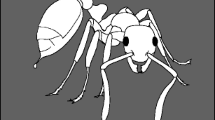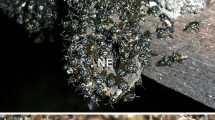Summary
Mandibular glands of the ant,Wasmannia auropunctata, contain 2,5-dimethyl-3-isopentylpyrazine, a compound which attracts nestmates to disturbed workers. During interspecific aggressive encounters, this small ant may utilize the alkylpyrazine as a repellent as well as disabling opponents with its potent sting venom. Alkylpyrazines have been previously identified as cephalic products from ants of the subfamilies Ponerinæ, Formicinæ, and Dolichoderinæ but this is the first report of an alkylpyrazine from the mandibular glands of a member of the Myrmicinæ.
Zusammenfassung
Die mandibularen Drüsen der AmeiseWasmannia auropunctata enthalten 2,5-dimethyl-3-isopentylpyrazin, eine Verbindung mit der andere gleich-artige Nestbewohner von gestorten Arbeitern herbeigelockt werden. Während einer aggressiven interspezifischen Begegnung kann die kleine Ameise das Alkylpyrazin als ein Abstossungsmittel benutzen und ihren Opponenten noch dazu mit ihrem wirkungsvollen giftigen Stich untauglich machen. Alkylpyrazine sind schon früher in Vertreten der Unterfamilien Ponerinæ, Formicinæ und Dolichoderinæ gefunden worden, jedoch ist dies der erste Bericht über Alkylpyrazine in den mandibularen Drüsen einer Art der Myrmicinæ.
Similar content being viewed by others
References
Blum M.S., Hermann H.R., 1978. — Venoms and venom apparatuses of the Formicidæ: Myrmecinæ, Ponerinæ, Dorylinæ, Psuedomyrmecinae and Formicinae. In: Arthropod venoms. Handbook of Experimental Pharmacology, Vol. 48. S. Bettini, ed. Springerverlag, Berlin, pp. 801–869.
Blum M.S., Jones T.H., Holldobler B., Fales H.M., Jaouni T., 1980. —Alkaloidal venom mace: Offensive use by a thief ant.Naturwis., 67, 144–145.
Brown W.V., Moore B.P., 1979. — Volatile secretory products of an Australian Formicine ant of the genusCalomyrmex (Hymenoptera: Formicidæ).Insect Biochem., 9, 451–490.
Cavill G.W.K., Houghton E., 1974. — Volatile constituents of the Argentine ant,Iridomymex humilus.J. Insect Physiol., 20, 2049–2059.
Cross, J.H., Byler R.C., Ravid U., Silverstein R.M., Robinson S.W., Baker P.M., Oliveira J.S. de, Jutsum A.R., Cherrett J.M., 1979. — The major component of the trail pheromone of the leaf cutting ant,Atta sexdens rubropilosa Forel.J. Chem. Ecol., 5, 187–203.
Duffield R.M., Blum M.S., Wheeler J.W., 1976. — Alkylpyrazine alarm pheromones in primitive ants with small colonial units.Comp. Biochem. Physiol., 54 (B), 439–440.
Holldobler B., 1973. — Chemische strategie beim Nahrungserwerb der Diebsameise (Solenopsis fugax Latr.) und der Pharaoameise (Monomorium pharaonis L.).Œcologia, 11, 371–380.
Longhurst C., Baker R., Howse P.E., Speed W., 1978. — Alkylpyrazines in ponerine ants: Their presence in three genera, and caste specific behavioural responses to them inOdontomachus troglodytes.J. Insect Physiol., 24, 833–837.
MacConnell J.G., Blum M.S., Fales H.M., 1974. — New alkaloids in the venoms of fire ants.Ann. Entomol. Soc. Am., 67, 134–135.
Regnier F.E., Wilson E.O., 1968. — The alarm-defense system of the antAcanthomyops claviger.J. Insect Physiol., 14, 955–970.
Regnier F.E., Wilson E.O., 1968. — The alarm-defense system of the antAcanthomyops claviger.J. Insect Physiol., 14, 955–970.
Smith M.R., 1965. — House-infesting ants of the Eastern United States: Their recognition, biology and economic importance. U.S.D.A.Tech. Bull., 1326, 1–105.
Spencer H., 1941. — A small fire ant,Wasmannia, in citrus groves — a preliminary report.Fla. Entomol., 24, 4–14.
Stenhagen E., Abrahamsson S., McLafferty F.W., 1974. —Registry of Mass Spectral Data, Vol. I, John Wiley, New York, p. 695.
Wheeler W.M., 1929. — Two neotropical ants established in the United States.Psyche, 36, 89–90.
Wheeler J.W., Blum M.S., 1973. — Alkylpyrazine alarm pheromones in ponerine ants.Science, 182, 501–503.
Author information
Authors and Affiliations
Rights and permissions
About this article
Cite this article
Howard, D.F., Blum, M.S., Jones, T.H. et al. Behavioral responses to an alkylpyrazine from the mandibular gland of the antWasmannia auropunctata . Ins. Soc 29, 369–374 (1982). https://doi.org/10.1007/BF02228764
Received:
Accepted:
Issue Date:
DOI: https://doi.org/10.1007/BF02228764




